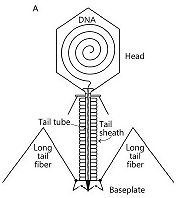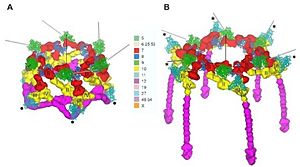Sandbox Reserved 717
From Proteopedia
| |||||||||
| 1ocy, resolution 1.50Å () | |||||||||
|---|---|---|---|---|---|---|---|---|---|
| Ligands: | , , | ||||||||
| Related: | 1h6w | ||||||||
| |||||||||
| |||||||||
| Resources: | FirstGlance, OCA, RCSB, PDBsum | ||||||||
| Coordinates: | save as pdb, mmCIF, xml | ||||||||
1OCY : ONE COMPONENT OF THE BACTERIOPHAGE T4 SHORT TAIL FIBRE
Contents |
Description of Bacteriophage T4

Bacteriophage T4 belongs to the Myoviridae family and the Caudovirales order. It belongs to this order and family because of its complex tail structure. Many proteins are involved in this complex tail structures. It infects Escherichia coli bacteria.
It consists of three parts : a DNA-containing head, a doubles-tubed tail with a contractile outer tail-sheath and a baseplate with long and short tail fibers.
Each bacteriophage T4 baseplate is composed of at least 16 different gene products, also called gp which are oligomeric proteins. These gene products can be divided in two groups: the six long and the six short tail fibers (on the schematic representation, on the left, not all shown tail fibres are shown). They form a multiprotein machine which plays an important role in the first stage of a phage infection. It is essential for the host cell recognition, the attachment of the bacteriophage and the sheath contraction which allows the viral DNA ejection. [2]
Adsorption and penetration phases

First, the viral particles recognize and bind reversibly to the outer membrane protein C (OmpC) or the cell-surface lipopolysaccharide receptors thanks to six long tail fibers which are connected to the baseplate. After at least three long tail fibers have bound, the baseplate changes conformation: from a hexagon shape, it becomes a six-pointed star. This change can be the result of changing the interactions between proteins. It has two consequences.
The first one is the unfolding of the short tail fibers, which are under the baseplate. Thus, they are able to attach irreversibly to the host cell surface.
The second one is the induction of the tail sheath’s contraction. Afterwards the tail tube is driving through the cell membrane. The activated lysozyme domain of gp5 degraded the peptidoglycan layer.
To finish, the phage DNA single-stranded is injected into the bacterial cytoplasm through the tail tube.
Presentation of gp12
| |||||||||||
Ligands and their Binding-Sites
So4
In the gp12 there are two molecules of SO4 ligands. One of them interacts with the citric acid. The blue molecule is the SO4. The other . It builds two hydrogen bounds to Ser287 with the distances 2.66 Å and 3.20 Å.
Citric Acid
The is drawn in green. It interacts with following amino acids: Arg465 (distance 3.01 Å), Asp455(distance 2.42 Å) and Tyr454 (distance 2.94 Å). . These interactions are caused by hydrogen bounds.
Zinc
The zinc is located in the centre of the receptor-binding domain. The zinc-binding site lies on the border between the head and the bonnet of the 45kDa domain. It interacts with the amino acids of each monomer. The distances of the zinc ion to the NE2 of and are 2.22 Å and 2.25 Å. The normally found distances between His and zinc are shorter. The explaination that these distances are longer than normally found is the octahedral coordination of the zinc in this structure [3]. The role of the zinc ion is probably absolute of structural nature. It increases the stability of the C-terminus of gp12 against proteases, but it also raises the stability of the C-terminus in general [3].
Applications
The most important role of gp12 is its ability to recognize and adhere to the host cell. Three other gene products (gp36, gp37 and gp38) are also targeting proteins and have a similar function. Nowadays some patents actually use random changes to create a bank of genetically modified bacteriophages. Recombinant bacteriophages are becoming a hope for treatment against multiresistant bacterial strains. [5]
External Ressources
References
- ↑ 1.0 1.1 1.2 Leiman PG, Arisaka F, van Raaij MJ, Kostyuchenko VA, Aksyuk AA, Kanamaru S, Rossmann MG. Morphogenesis of the T4 tail and tail fibers. Virol J. 2010 Dec 3;7:355. doi: 10.1186/1743-422X-7-355. PMID:21129200 doi:10.1186/1743-422X-7-355
- ↑ Kostyuchenko VA, Leiman PG, Chipman PR, Kanamaru S, van Raaij MJ, Arisaka F, Mesyanzhinov VV, Rossmann MG. Three-dimensional structure of bacteriophage T4 baseplate. Nat Struct Biol. 2003 Sep;10(9):688-93. Epub 2003 Aug 17. PMID:12923574 doi:http://dx.doi.org/10.1038/nsb970
- ↑ 3.00 3.01 3.02 3.03 3.04 3.05 3.06 3.07 3.08 3.09 3.10 3.11 3.12 3.13 3.14 3.15 3.16 3.17 3.18 3.19 Thomassen E, Gielen G, Schutz M, Schoehn G, Abrahams JP, Miller S, van Raaij MJ. The structure of the receptor-binding domain of the bacteriophage T4 short tail fibre reveals a knitted trimeric metal-binding fold. J Mol Biol. 2003 Aug 8;331(2):361-73. PMID:12888344
- ↑ van Raaij MJ, Schoehn G, Jaquinod M, Ashman K, Burda MR, Miller S. Identification and crystallisation of a heat- and protease-stable fragment of the bacteriophage T4 short tail fibre. Biol Chem. 2001 Jul;382(7):1049-55. PMID:11530935 doi:10.1515/BC.2001.131
- ↑ EP2097516 (B1) - Method for preparing bacteriophages modified by the insertion of random sequences in the screening proteins of said bacteriophages, IRIS FRANCOIS, PHERECYDES PHARMA
Proteopedia Page Contributors and Editors
Anne-Lise Terrier, Bianca Waßmer

